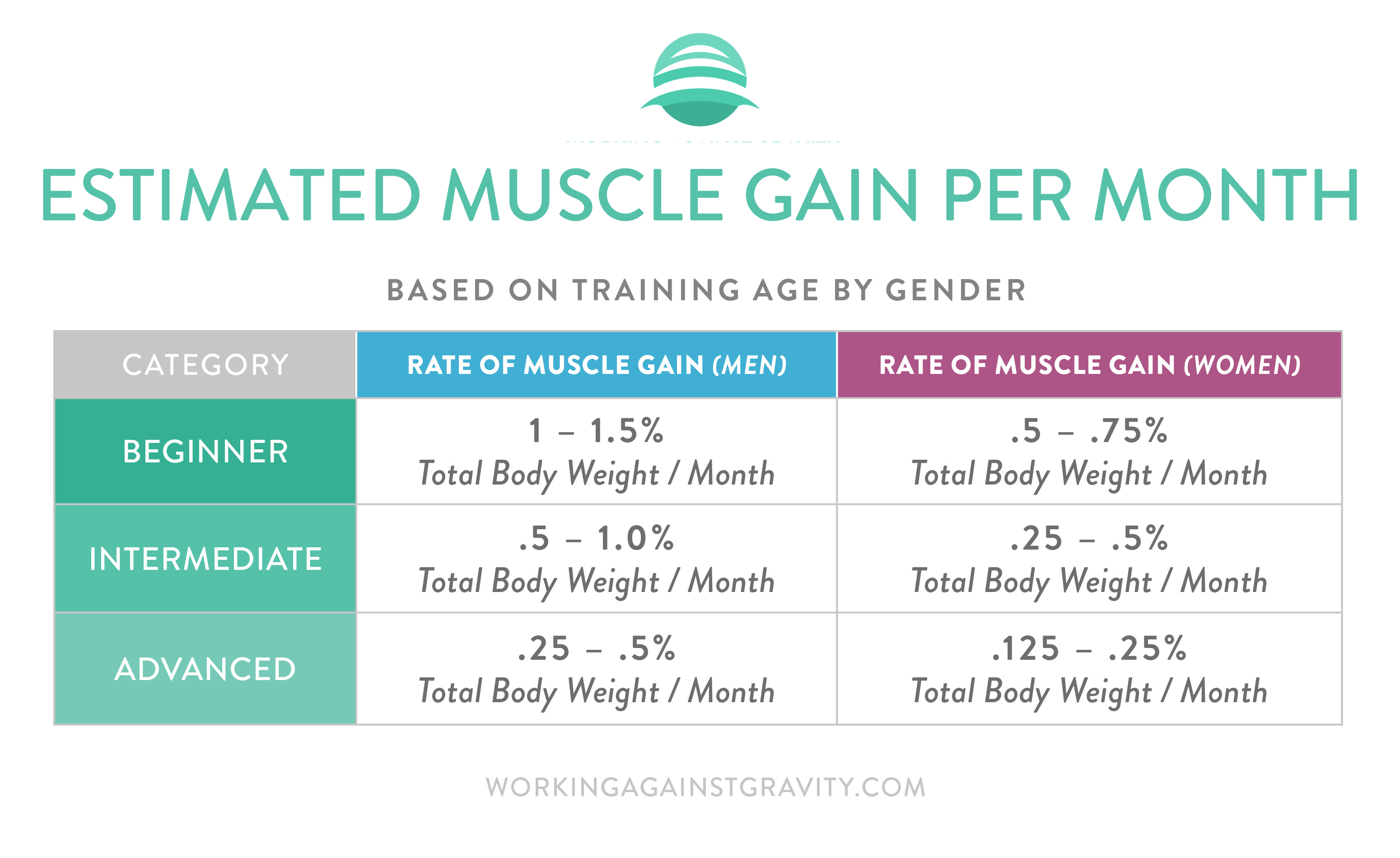
There are a lot of contributing factors to gaining muscle mass, so before we go into the “how-to,” let’s start with what you can expect.
Gaining muscle might take a little longer than anticipated, especially if you’ve been training for a while — patience is key. Many people who enter a massing phase are coming out of a cut when the body may have gotten used to significant changes in composition, so it’s important to keep in mind that this is an entirely different process for your body!
Another truth about muscle gain is that your body will be in a caloric surplus and there will be some inevitable fat gain (which can be minimized if a bulk is approached correctly). For these reasons, many people get frustrated when trying to gain muscle, but we’re here to help you with some of our tips for gaining muscle!
First, let’s start with the chart below—it helps illustrate a rough estimate of muscle gain per month based on training age and gender. [1]

Advertisement
Start by picking a path!
When asked about your physique and athletic goals, there’s a pretty good chance the answer would be to add muscle or lose fat (maybe both!). While BOTH can be tackled together, it’s far more efficient to choose one phase to focus on 100% at a time rather than going back and forth between a small surplus and a small deficit. The exception to this rule would be overweight untrained individuals or individuals returning to training after time off because resistance training in combination with proper nutrition will provide a new stimulus for the body to help kickstart their goals. [2]
Reset your protein
In the health and fitness industry, protein is often touted as being the most important macro to focus on when it comes to gaining and retaining lean mass. Don’t get us wrong, protein IS important, but there are some instances where “less is more”—bulking is one of them! When your body is consuming calories in a surplus, protein demands drop closer to 0.7–1.0 g/lb. [2,3]
An easy way to think about this is to think about how you would eat when your body is in a deficit. In this case, your body is consuming fewer calories than you burn, so your body is more prone to feed off muscle, creating a need for a higher protein intake. Since your goal is to retain lean mass, a higher protein diet is muscle-sparing [2,4,5] and increases satiation levels. This scenario is preferable for dietary adherence in a deficit, but not necessarily while in a surplus.
While in a surplus, setting protein intake slightly lower than you would in a deficit allocates more calories to carbohydrates, which may aid in glycogen restoration after training as well as provide energy for training sessions. [6] The less satiating quality of carbohydrates in comparison to protein may aid in dietary adherence since hunger levels are generally lower.
Keep food quality high
When your daily calorie targets and macronutrient goals are higher than what your WAG Coach may have assigned for cutting, it might be tempting to go the route of gummy bears and protein shakes. While it’s okay to enjoy the added flexibility of eating more, it’s still important to ensure you’re eating a wide variety of whole-food carbohydrates that will provide your body with micronutrients and fiber, which are important for health and recovery.
Advertisement
This could include:
- Sweet potato/potato
- Whole grains
- Oatmeal
- Denser fruits such as banana, pineapple, mango
- Dried fruit
- Legumes
- Smoothies
For more ideas, check out this blog on Easy Ways to Add Carbs to Your Day.
No train, no gain
Food is the fuel behind gaining muscle, but that fuel needs to be put to work in the gym! If you don’t have two hours a day, six days a week to commit to weight training, that is OKAY. It’s more important to train smart than to be at the gym for several hours. If you currently do not train, start with two days per week and build from there. If you’re looking for some ideas for how to get started with training, check out our Training Programs for a Busy Schedule, or if you are a current WAG member, access our training templates in the Knowledge Base!
Not all bulks are created equal
To approach a bulk correctly, it’s important to consider that just because the scale is moving up, it doesn’t necessarily mean that weight is muscle. Gaining weight for the sake of it is going to have a marginal impact on strength, and might not fit with your composition goals. Going on a “see-food” diet (meaning you basically eat everything in sight) without structure is not going to yield the desired results.
Obviously, there is a lot going on here. So, if you're feeling a bit overwhelmed, we've got your back. A 1:1 nutrition coach will make all the difference.
Advertisement
References:
References:
- Adapted from: McDonald, L. (2018, October 19). Muscle Gain Math. Retrieved January 28, 2019, from https://bodyrecomposition.com/muscle-gain/muscle-gain-math.html/#more-13913
- Helms, E., Morgan, A., & Valdez, A. (2019). The Muscle & Strength Pyramid (2nd ed.) p. 84-118
- Willoughby, D.S., J.R. Stout, and C.D. Wilborn, Effects of resistance training and protein plus amino acid supplementation on muscle anabolism, mass, and strength. Amino Acids, 2007. 32(4): p. 467–77
- de Souza, R. J., Bray, G. A., Carey, V. J., Hall, K. D., LeBoff, M. S., Loria, C. M., Laranjo, N. M., Sacks, F. M., … Smith, S. R. (2012). Effects of 4 weight-loss diets differing in fat, protein, and carbohydrate on fat mass, lean mass, visceral adipose tissue, and hepatic fat: results from the POUNDS LOST trial. The American Journal of Clinical Nutrition, 95(3), 614-25.
- Mettler, S., Mitchell, N., & Tipton, K. D. (2010). Increased Protein Intake Reduces Lean Body Mass Loss during Weight Loss in Athletes. Medicine & Science in Sports & Exercise, 42(2), 326-337. doi:10.1249/mss.0b013e3181b2ef8e
- Murray, B., & Rosenbloom, C. (2018). Fundamentals of glycogen metabolism for coaches and athletes. Nutrition Reviews, 76(4), 243-259.
Get a WAG Coach
Working Against Gravity has led the macro tracking and health space for over a decade. Our team doesn’t just understand the science of nutrition—we’ve spent years mastering the art of tailoring it to fit your life. That means no cookie-cutter plans, just real strategies that have worked for over 30,000 people.
Choose from our membership options and start working with an expert 1-on-1 coach today.



